 Thursday, 06 November 2008
Jesse Kaplan gave a GREAT talk at PDC called Managed and Native Code Interoperability: Best Practices. I really enjoyed it, and it actually covers a great deal of ground. Sure, some of the diagrams expressed concepts I have expressed before, but that's a vote of confidence as far as I'm concerned.
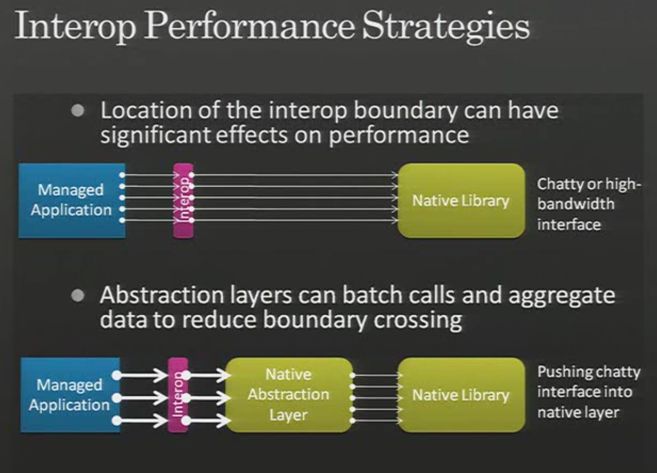
This is a dense talk that assumes a fair amount of background knowledge, but well worth the hour to watch. And then he plugged my marshal-as site, too!
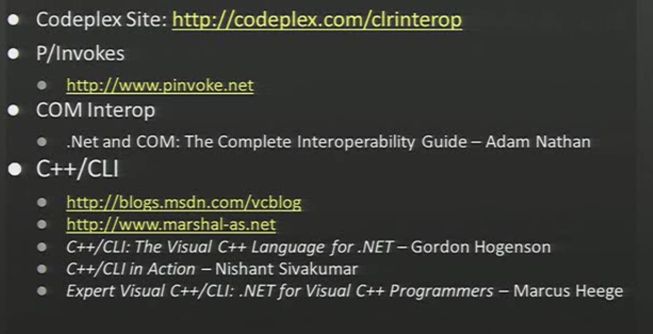
Dude, you had me at "interop boundary" and it just got better from there. But this was a great finish!
Kate
 Wednesday, 05 November 2008
Microsoft has announced BizSpark. If you know what DreamSpark is, then you might guess what BizSpark is. I was really surprised myself - essentially unlimited free licenses of developer software and hosting software such as Windows, SQL Server and SharePoint. Yes, free Team Suite for everyone in the company! You must meet three criteria:
- Be a startup, less than 3 years in business
- Have not much revenue, less than a million a year (stricter in some markets, mostly in Asia)
- Be software developers, not consultants or resellers
You prove that you meet these criteria, not to Microsoft, but to a network partner. Ideally your network partner is more than just your gateway to free software, but someone who can advise and help you on the path to success. Since the network partner has to know a bit about you, not many will just email you a key if you email them. You can look through the partners on the BizSpark site and see who would be a good match for you to establish a relationship with. Be sure to get the user guide and read the FAQ as well.
Plenty of coverage of this elsewhere on the web:
etc etc.
So, if you fit the description and want the free software, what should you do? Go to the BizSpark site's Find a Network Partner page. A lot of them are venture capitalists and investment companies. If you were hoping to find such a firm, this is a cool way to know one that is in favour of your using the Microsoft platform and won't try to make you change development tools to get funded. If you weren't planning to work with an investor, scroll through looking for a firm that offers consulting and mentoring. You can send an email and see about working together. If you can't find a firm in your geography that looks as if it could help you, try a nearby geography. For example, I'm only listed under Canada, but Americans could engage with our firm too.
Kate
 Tuesday, 04 November 2008


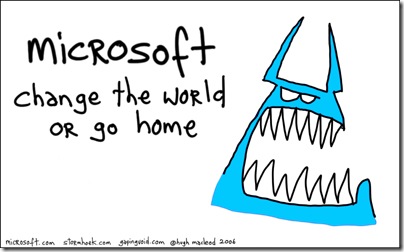
All three from Steve Clayton's blog which I admire tremendously. The monster (Blue Monster updated to Azure Monster)matches the logo to my eye and they're both lighter and greener than the hex from the shirt. Btw I pronounce Azure with the emphasis on the first syllable 
Kate
ps: No clue what Azure is yet and wish someone would post about that instead of colours and pronounciations? Try http://blogs.zdnet.com/microsoft/?p=1671 for Mary Jo's take.
 Monday, 03 November 2008
More PDC goodness.
Steven Sinofsky is the senior vice president for the Windows and Windows Live Engineering Group at Microsoft. He was awesome in the Day 2 keynote. Then he walked down to The Big Room and did a half hour Open Spaces talk with attendees. I recognized fellow RDs Tim Huckaby and David Yack among them. The sound quality varies but the recording is well worth watching to see how comitted he is to the Engineering 7 blog and to communicating with developers.
Then there's Joey deVilla. I've been reading his personal blog for ages and his technical blog once in a while - he was an open source guy so it wasn't always relevant to me. I love his sense of humour and spirit of community. I was delighted to learn that he would replace the departing Jean Luc David (our loss is Redmond's gain.) While at PDC, he interviewed Don Box, Miguel de Icaza, John Lam, Phil Haack and some of the .NET Micro Framework team. Great ways of learning some of what happened at PDC and getting to know Joey a little better.
But he wasn't the only one! John Bristowe was also busy with the camera. He interviewed Joel Semeniuk (another RD) and some people from Windows Home Server. This is a product I am hearing a lot of praise for that I really should install on a spare machine.
I love these videos because they start to capture some of the non-session parts of the conference. If you're wondering why on earth you would go to a conference and not go to sessions, look at these conversations. Also look in the background at the other conversations and interactions. Face time is why we all come to the same place. Sessions are a bonus.
Kate
 Sunday, 02 November 2008
We're building a backyard shed, and I recruited a certain young teen to help. Sooner than I expected, he was back inside the house. "Finished already?" "I need a rest." But I only see two or three pieces of wood carried from the under-roof storage area to the work zone. It turns out that he kept bringing the wrong piece of wood (2 x 4 when asked for 2 x 6, or 8 foot when asked for 10 foot) and having to take it back and go get the right one. This is tiring, of course. But I also found it illuminating because a similar thing happens with my new hires who are straight from school or university.
In an academic setting, if I assign you the task of getting me a 10 foot 2 x 6, and you bring me a 10 foot 2 x 4, or an 8 foot 2 x 6, I will probably give you a pretty good mark. Not 10/10, of course, but at least 7. After all, you have brought me wood, as opposed to a rabbit or some mashed potatoes. You have come back with something, rather than wandering off into the woods to play or inside to watch TV. You have even got one of the dimensions right and the other close to right. So you receive your mark and you're done. Similarly when I mark a programming assignment, maybe I spot a logic flaw or other mistake, your code won't work under certain circumstances, but it works some of the time, or almost works, or at least doesn't always blow up. I can give you 7/10.
In the real world, whether of shed building, or code writing, things are more binary. I have the wood I need or I do not. Your code meets our standards or it does not. And here is the key thing - you have to make it right. Take this wood back and bring a longer piece, or a wider piece. Take this code back and make it so it can accept strings with apostrophes in them, or so the title is centred, or whatever other bug you need to fix. You're not done until it's right.
It's a lesson that probably needs to be taught more explicitly to the new grad. It wouldn't hurt to teach it a bit in those academic settings.
Kate
 Saturday, 01 November 2008
One of my demos (OK, more than one) for my upcoming Tech Ed Europe talks is a console application. I find when you're doing complicated concepts like C++ templated code, that adding the plumbing to talk to a Windows application (whether MFC, Windows Forms, WPF or whatever) can obscure what's going on. Generally speaking people can follow cout << i << endl; just fine and it reduces the header files and so on that are needed to use the sample.
I had one problem though - on this machine, when debugging a console application I couldn't get the Properties of the command prompt to come up when stopped at a breakpoint, and of course the command prompt disappears as soon as the program finishes running. I could change the properties in the command prompt you get for "start without debugging" but they had no effect on the debug one. The font was too tiny to use in a presentation:

Here's what I did. I brought up any old command prompt, right-clicked in the title bar, and chose Defaults instead of Properties. This affects every command prompt on your machine at once. I switched to Lucida Console and a bigger size, and closed the command prompt, then debugged my console application again:

Do I care that the font is now big in all my other command prompts? Not really. I suppose if I did I could deal with their properties one by one.
Kate
 Friday, 31 October 2008
An interesting thing happened towards the close of Thursday's MFC session at PDC. Damien Watkins was taking questions, and as so often happens, some of the questions were really more comments or suggestions, feature requests and so on. It's rare for the speaker to be the person who can act on these requests. Normally we're reduced to saying "send me an email and I'll forward it to the right people." Sadly, very few attendees do that. I know it takes a great deal of initiative and even courage to ask a question at a big conference (I do remember my pre-speaker days) and when asked to send email instead, that is sometimes too high a hurdle. As a speaker I can try to make a note of it, but if it's outside my area I may not write down the most important word of the request and that may leave the team unable to respond.
So during Thursday's session, after the third or fourth "OK, I'll pass that along," Damien volunteered:
I know you're thinking "he's just nodding his head and not paying any attention", but if you're using the mike it's all getting recorded. Everybody back on the team says "hey, as soon as it's online, let us know so that we can go ahead." It is getting recorded so it's all going back.
After the talk, Damien told me that they recorded the MVP Summit sessions and replayed them frequently to hear the attendee comments in context and with precision. For the PDC talks, when they need to share comments with another team, it's as simple as sending them a URL and a minute mark and asking them to listen. In fact I've done that myself this week when asking a question of someone in Redmond who couldn't attend - I sent the URL to the talk, a screenshot of the slide, and the minute mark. One of the easiest followup emails to compose ever. It really makes it possible for the conversation to continue long after the conference. I hope the trend spreads to all my conferences.
Kate
 Thursday, 30 October 2008
Did you get a set of DVDs for Tech Ed USA this year? I did, and I find them incredibly valuable. But when I went to use one recently, I had a problem: it asked me to install Silverlight. That was weird, since I have Silverlight - in fact I have the latest version. But when I clicked the link, the problem got worse:

I contacted the folks in charge of the DVDs and they told me that in fact you can still get to all the content as long as you know the session code. The only hard part is finding the right disk. Then you browse to the folder for the session:
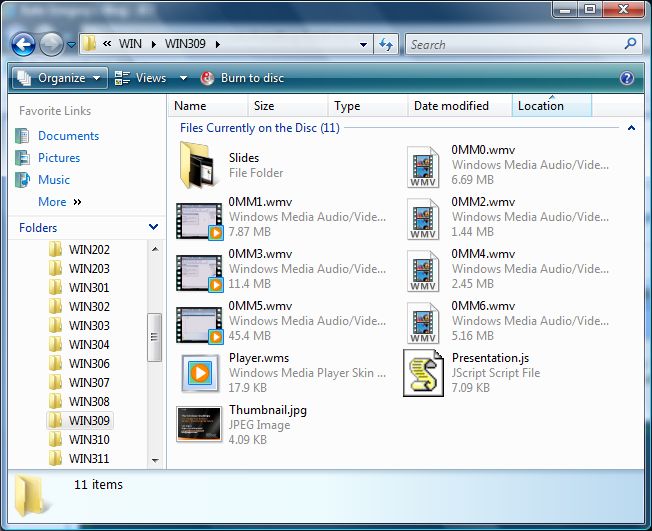
Once there, double click Player.wms and you should be all set.
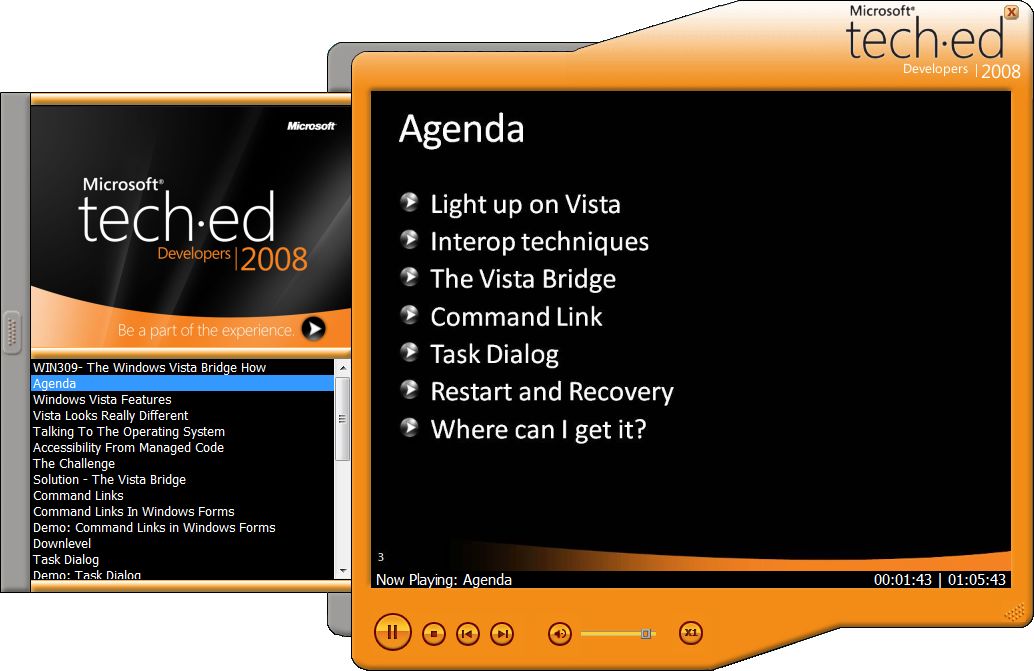
I shrank the picture so it would fit in the blog - the text looks perfectly normal in real life.
The online site has been updated to Silverlight 2, but this lets you continue to use your DVDs. There's also a handy index of talk titles and speaker names, which I have been permitted to upload. It's an attachment to this post.
So enjoy your Tech Ed content!
Kate TechEd 2008 North America DVD Compatibility Issues.pdf (617.2 KB)
© Copyright 2024 Kate Gregory
Theme design by Bryan Bell
newtelligence dasBlog 2.3.9074.18820   | Page rendered at Saturday, 23 November 2024 04:59:33 (Eastern Standard Time, UTC-05:00)
|
On this page....
Pluralsight Free Trial
Search
Navigation
Categories
Blogroll
Sign In
|